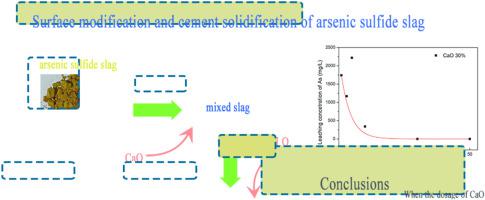Journal of Cleaner Production ( IF 9.7 ) Pub Date : 2023-02-22 , DOI: 10.1016/j.jclepro.2023.136491 Ruibing Li , Zhixin Yao , Sansan Yu , Ting-an Zhang , Dajin Yang

|
Arsenic sulfide slag (ASS), the product of sulfide precipitation from arsenic wastewater, needs further processing to protect the environment. Oxidation of trivalent to pentavalent arsenic with H2O2 and stabilization of arsenic with CaO in the form of water-insoluble calcium arsenate, Ca3(AsO4)2, are now relatively mature methods. Their disadvantages, however, are the large amounts of sludge produced and of the oxidant H2O2 used. In this paper, to reduce the use of lime and the oxidizing agent, surface modification of arsenic sulfide particles (ASP) was studied. ASS was mixed with calcium oxide in different proportions to obtain mixed slag which was oxidized with hydrogen peroxide. High-resolution spectroscopic examination showed that calcium arsenate completely covered the ASP surface when the stoichiometric amounts of H2O2 and CaO were 50 and 100%, respectively. The stability of the arsenic in the surface modified ASP was evaluated using USEPA toxicity characteristics leaching procedure (TCLP) in which the ASS was cured with cement. The arsenic leaching concentration from the solidified body in which the ASS to cement ratio is 1:2 could be reduced to 0.63 mg/L for dosages of 30% CaO and >30% H2O2, which is lower than the USEPA and Chinese regulatory thresholds of 5 mg/L and 1.2 mg/L, respectively. The method developed successfully saves a large quantity of the hydrogen peroxide oxidant and has the potential to reduce industrial toxic arsenic slag discharge.


















































 京公网安备 11010802027423号
京公网安备 11010802027423号